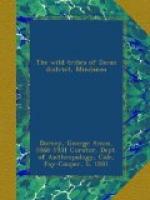In the preparation of this paper I have, so far as possible, drawn on the knowledge of others to fill in the gaps in my own notes. In spite of this the information on certain groups is still so scanty that this can be, at best, only a sketch. It is offered at this time in the hope that it may serve as a help to other anthropologists who may plan to visit this most interesting field.
I wish here to extend my thanks to the various civil and military authorities who gave me valuable assistance; also to Captain James Burchfield, H. S. Wilson, James Irwin, Otto Hanson, William Gohn, Henry Hubbell, and Juan de la Cruz, planters, whose wide knowledge of, and acquaintance with the interior tribes made possible my work in many localities.
It is a pleasure and a duty to acknowledge the assistance rendered by my wife, who accompanied me throughout my Philippine work. Her presence made it possible to secure the complete confidence of the hill people, and thus to gain an insight into their home life which otherwise would have been impossible. A large part of the material here presented, particularly that relating to the women, was gathered by her and many of the photographs are from her camera.
The dialects spoken by the tribes of central and southern Mindanao are to be dealt with in a separate publication, so that at this time I shall merely give a brief description of the characters appearing in the native names used in this paper. The consonants are pronounced as in English, except r which is as in Spanish. c is used as ch in church, _~n_, which occurs frequently, is a palatal nasal. There is no clear articulation and the stop is not present, but the back of the tongue is well up on the soft palate.
The vowels are used as follows: _-a_ like a in father _-e_ like a in fate _-i_ like i in ravine _-o_ like o in note _-u_ like u in flute a, e, i, o, u, short of the above.
E is a sound between the obscure vowel e, as e in sun, and the ur in burrow.
The dipthongs[sic] are ai like ai in aisle, au like ou in mouse, or final Spanish ao as in carabao, ei like ei in eight, oi_ as in boy, also Eu, eu, etc.
FAY-COOPER COLE,
Assistant Curator of Malayan Ethnology.
CHICAGO, September, 1913.
I. THE BAGOBO.
SYNONYMS:
(a) GUIANGA, GUANGA, GULANGA
(b) OBO
(c) TIGDAPAYA
(d) ETO
HABITAT.




